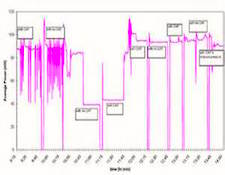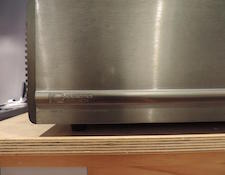It’s the time of year for saving money!
Back in the 1980s, a fellow named Owen Bennett had a “forehead-slapper” idea; you know the kind I mean ― the ones that are so obvious that you wonder why nobody’s ever thought of it before. Or, more importantly, why YOU’ve never thought of it before. In any case, Owen’s idea was one of those, and it was based on a simple fact of physics: EVERYTHING has a fundamental resonance frequency at which it vibrates when stimulated, and the amplitude of that vibration is determined by just two things: the amplitude of the stimulus and the frequency of the stimulus, with the effective amplitude of the stimulus varying not only with its actual energy level, but with the proximity of its frequency of stimulus to the fundamental resonance frequency of the object being stimulated ― the closer, the greater.
 In simplest language, what that means is that if an object has a “natural” (fundamental) resonant frequency of 100Hz and you stimulate it with 1kHz it will vibrate (THIS) much at 100Hz. And if you double the amount of 1kHz stimulation it will vibrate at 100Hz twice as much. OR, if instead of doubling the amount of the original 1kHz stimulus, you keep the amount the same, but drop the frequency of stimulus to 500Hz, you’ll still get twice as much vibration at 100Hz.
In simplest language, what that means is that if an object has a “natural” (fundamental) resonant frequency of 100Hz and you stimulate it with 1kHz it will vibrate (THIS) much at 100Hz. And if you double the amount of 1kHz stimulation it will vibrate at 100Hz twice as much. OR, if instead of doubling the amount of the original 1kHz stimulus, you keep the amount the same, but drop the frequency of stimulus to 500Hz, you’ll still get twice as much vibration at 100Hz.
Hmmmmm… So how would that work in a loudspeaker?
Consider, for example, a tweeter with the (reasonably typical) fundamental resonance of 1500Hz (1.5kHz). Consider, also, that, in keeping with customary design practice it will never be used at anything less than 3kHz ― one full octave above its fundamental resonance. (A crossover network will reduce the signal sent to it by, typically, anywhere from 6dB to 24dB per octave). Now, let’s suppose that we play a 12kHz tone (possibly cymbal “shimmer”) through this tweeter. What sound(s) do you think it will produce? Yup, 12kHz PLUS the 1.5kHz fundamental resonance frequency, PLUS (but to a much lesser degree) all of the harmonics ― 3k, 4.5k, 6k, 7.5k, etc. ― of that 1.5kHz tone.
Yes, regardless of what frequency we feed into that tweeter as part of our music signal, in addition to playing the signal that we feed to it from our amplifier, it will also “sing along” with the music tones at its fundamental resonance frequency, and the volume level of the “sing-along” tone will vary, both with the volume of the music tone being played and with how close the frequency of the music tone is to the frequency of the fundamental resonance. IN SHORT, NO MATTER WHAT WE PLAY THROUGH THAT TWEETER OR ANY OTHER LOUDSPEAKER DRIVER, WE WILL NEVER HEAR JUST THE MUSIC TONES DESIRED TO BE PLAYED, BUT ALSO A CONSTANT-BUT-VARYING-IN-VOLUME “DRONE” ― A SECOND (SPURIOUS) TONE AT THE FUNDAMENTAL RESONANT FREQUENCY OF THE DRIVER.
Simply using a crossover, regardless of whether passive or active, or even separating the frequency band into multiple segments and using multiple amplifiers to cover it can’t solve this problem, because the spurious tone isn’t coming from the incoming signal, but from the vibration of the active elements of the driver, itself, which serve as the stimulus.
 There IS a solution, however, and Bennett Sound Corporation (“BSC”), a division of Kinergetics Research named after Owen Bennett, developed it, patented it, and produced a line of speakers based on it. And, when one of the company’s models was reviewed in The Absolute Sound, the reviewer (it might even have been HP, but I don’t recall for sure) LOVED it!
There IS a solution, however, and Bennett Sound Corporation (“BSC”), a division of Kinergetics Research named after Owen Bennett, developed it, patented it, and produced a line of speakers based on it. And, when one of the company’s models was reviewed in The Absolute Sound, the reviewer (it might even have been HP, but I don’t recall for sure) LOVED it!
What BSC did was to develop a circuit (a “trickery” circuit) that would analyze the frequency content of the incoming signal to be sent to each driver, calculate the level of the spurious fundamental resonance it would produce, and feed a signal exactly sufficient to equal only that level of resonance to (except for the woofer) the next lower frequency driver, where it would be played out of phase, to cancel-out the effects of unwanted fundamental resonance in the next driver up. To accomplish this, BSC used a separate captive amplifier for each driver, with, except for the tweeter amp, one or more trickery circuits built in, so that, in a four-way system, for example, the midrange amp would produce and cause the midrange driver to play the canceling tone for the tweeter; the mid-bass amp and driver would play the canceling tone for the midrange driver; and the woofer amp would (with TWO trickery circuits built in) produce and cause the woofer to play two canceling tones, one for the mid-bass driver and one for itself.
The system worked brilliantly and, without the constant sing-along drone from all of the drivers, produced a level of clarity and sonic purity never possible to duplicate in any other way.
The problem with it, though, was that, because of the need for the various trickery circuits, the system had to use ONLY the amplifiers supplied for it by BSC. That, according to one of the principals of Kinergetics Research, BSC’s parent company, was its downfall: At the time that the speakers came out (the mid-1980s), most audiophiles insisted on being able to make their own choice of amplifier(s), and BSC and other companies offering self-powered systems (Boothroyd-Stuart Meridian, for example) found themselves facing levels of market resistance that, at least for BSC, proved fatal.
Things have changed since then, though. For some reason, buyers didn’t resist powered sub-woofers, and, over time, perhaps following the lead of Genelec and other high-performance powered studio monitors and the trend toward simplicity that has resulted in the recent growth in the market for High-End integrated amplifiers, self-powered speakers, while still not the norm, have become much more acceptable to many High-End buyers.
 Perhaps it’s time for the re-appearance of speakers following or emulating the BSC model. The patents must certainly have expired by now, and perhaps other, more modern, approaches could be taken to even eliminate the need for captive amplification. At least two possibilities immediately come to mind, which I will be pleased to discuss privately with interested and qualified parties.
Perhaps it’s time for the re-appearance of speakers following or emulating the BSC model. The patents must certainly have expired by now, and perhaps other, more modern, approaches could be taken to even eliminate the need for captive amplification. At least two possibilities immediately come to mind, which I will be pleased to discuss privately with interested and qualified parties.
What do you think? Does anybody out there want to take advantage of proven, genuinely innovative and HIGHLY effective technology to create a new “powerhouse” speaker company? Or to add this now-public-domain breakthrough technology to an existing one?
I’ve heard the Bennett speakers, and if the time is finally right, I think a new application of their technology or something like it could be very exciting!






